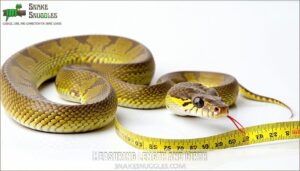This site is supported by our readers. We may earn a commission, at no cost to you, if you purchase through links.

Overfeeding is a common mistake—remember, snakes don’t need dessert! Keep an eye on signs like a thick, round body or folds near their scales, which can indicate excess weight.
Offer prey that matches your snake’s species and size, and adjust feeding schedules to prevent overindulgence. A little exercise helps too—encourage movement by rearranging their enclosure or adding climbing spots.
Always monitor their progress, and consult a vet if you’re unsure. With care, you’ll keep your scaly friend healthy and thriving. Curious how to make their meals more balanced? Stay tuned!
Table Of Contents
- Key Takeaways
- Identifying Overweight Snakes
- Snake Diet and Nutrition
- Creating a Weight Loss Plan
- Exercise and Environmental Enrichment
- Health Risks and Complications
- Frequently Asked Questions (FAQs)
- Are snakes overweight?
- What are the ways to control weight?
- Are snakes underweight?
- How do you know if a snake is underweight?
- Can a snake eat a picky eater?
- How do I maintain my weight as a recovered anorexic?
- How do I help my snake lose weight?
- What is the 4 3 diet for weight loss?
- How to help overweight ball python?
- What is the snake diet feeding window?
- Conclusion
Key Takeaways
- Measure your snake’s weight and body condition regularly to catch early signs of excess weight or poor health.
- Feed prey that matches your snake’s size and species, and space out meals to prevent overfeeding.
- Add climbing structures, larger enclosures, and interactive feeding to keep your snake active and engaged.
- Monitor progress with tracking tools, and consult a vet if your snake shows signs of obesity or health issues.
Identifying Overweight Snakes
Spotting an overweight snake isn’t as tricky as it might seem once you know what to look for.
By paying attention to their body shape, feeding habits, and overall movement, you can catch early signs of unhealthy weight gain.
Determining Ideal Weight
Figuring out your snake’s ideal weight isn’t guesswork—it’s all about careful observation and a few handy tools. Every species and age group has unique weight ranges, so species variation and age influence play a big role in defining what’s healthy.
Use these tips to assess your snake’s body condition:
- Body condition score: Check for fat deposits along the spine and tail.
- Girth charts: Compare your snake’s girth to species-specific measurements.
- Measurement tools: Use a kitchen scale and flexible tape for accuracy.
- Feeding habits: Watch for excessive appetite or food aggression.
Keeping up with snake weight monitoring guarantees your pet stays at its healthiest, happiest size.
Measuring Length and Girth
When measuring your snake’s size, use a flexible tape measure for accuracy.
Gently stretch your snake to measure its length from nose to tail.
Next, wrap the tape around the thickest part of its body to record girth.
You can easily find a suitable measuring tool online.
Compare these numbers to girth charts specific to your snake’s species, as species variation affects ideal sizes.
Regular measurement frequency guarantees effective snake weight monitoring and helps assess snake body condition for proper weight management.
Monitoring Feeding Habits
Tracking snake feeding habits is like managing a meal plan for a picky eater. Keep things on point with Prey Item Logging and Feeding Schedule Consistency.
- Feeding frequency: Stick to species-specific intervals.
- Portion size control: Match prey to your snake’s girth.
- Balanced diet variety: Rotate prey types for nutrition.
Consistent logging and calorie monitoring help prevent overfeeding while ensuring your snake stays healthy and active!
Recognizing Physical Signs
Spotting an overweight snake isn’t tricky if you know what to look for.
Keep an eye on their body condition score and watch for these signs:
| Sign | What to Look For | What to Do |
|---|---|---|
| Scale Spreading | Skin visible between scales | Adjust feeding habits |
| Spinal Depression | Spine sinks under fat | Encourage exercise |
| Sagging Belly | Soft, droopy underside | Reduce meal size |
| Lack Definition | Neck blends into body | Consult a vet |
Recognizing these changes helps you manage snake obesity and improve their body condition.
Captive snakes are prone to obesity due to limited exercise options.
Snake Diet and Nutrition
Feeding your snake the right diet is key to keeping it healthy and active.
By understanding its nutritional needs and sticking to proper portion sizes, you can avoid common issues like obesity or malnutrition.
Nutritional Requirements
A balanced diet is key to meeting your snake’s nutritional requirements.
Whole prey provides essential nutrients, but vitamin supplementation may be necessary, especially for calcium to support bone health.
Mix things up with prey variety and occasional food additives to keep meals interesting.
Proper snake nutrition guarantees smooth meal digestion and prevents deficiencies. Think of it as crafting the perfect menu for your reptile’s dietary needs!
Food Options and Prey Items
Feeding your snake is about smart choices and balance. Aim for prey items that suit its size and nutritional needs.
Frozen-thawed options are safer and easier to handle than live prey.
Here’s how to enhance your snake’s diet:
- Offer lean prey like mice for better health.
- Rotate prey types for variety.
- Use food additives or supplements occasionally.
- Match prey size to your snake’s girth.
To explore different snake food options, consider online retailers.
Feeding Frequency and Portion Control
When setting a snake feeding schedule, match prey size to the widest part of your snake’s body and adjust feeding intervals based on age.
Younger snakes need meals more often, while adults thrive on less frequent feedings.
A balanced diet with food variety is key, and logging schedules guarantees portion control, helping prevent snake obesity while keeping your pet healthy and stress-free.
Avoiding Overfeeding
Overfeeding sneaks up fast, turning your snake’s meal plan into a weight problem.
Stick to portion control by matching prey size to your snake’s girth and spacing meals per proper feeding frequency.
Avoid extra snacks or oversized prey that disrupt a balanced diet.
Consistently follow snake feeding guidelines, log meals, and offer varied prey to prevent snake obesity and guarantee healthy weight management.
Remember to avoid improper thawing practices of frozen prey.
Creating a Weight Loss Plan
Creating a weight loss plan for your snake requires a mix of small dietary changes and consistent monitoring.
By adjusting feeding schedules and encouraging more activity, you’ll help your pet shed extra pounds safely and stay healthy.
This approach will ensure your snake loses weight in a safe manner.
Setting Realistic Goals
How do you set realistic goals for snake weight management? It’s all about balance and patience. Focus on gradual changes to achieve a healthy snake weight without stress. Avoid rushing—slow and steady wins the race here.
- Create achievable timelines based on your snake’s individual needs.
- Develop sustainable habits like tracking weight and adjusting the snake diet.
- Monitor progress consistently with a kitchen scale and weight log.
Celebrate small wins (maybe with an extra climbing branch), and always consult a vet for personalized advice.
Adjusting Feeding Schedules
Tweaking your snake’s feeding schedule can work wonders for their health. Think of it like choosing the right meal plan—one size doesn’t fit all.
Feeding intervals depend on your snake’s age, species needs, and digestion time. Offer prey that’s around 10-15% of their body weight.
Younger snakes may eat weekly, while adults often need food every 10-21 days. Track portion sizes to avoid overfeeding or underfeeding.
Notice sluggish digestion? Spread out feeding intervals slightly. And always monitor their weight through a scale and body checks.
Your careful adjustments guarantee a happy, healthy snake that’s fed just right! A vital aspect involves understanding their natural carnivorous diet.
Increasing Physical Activity
Boost your snake’s activity by introducing climbing structures and enriching its habitat.
Try supervised outings in safe spaces or interactive feeding to mimic natural hunting.
A larger enclosure encourages exploration, while varied substrates and temperature gradients promote movement.
Regular handling benefits their health too—think of it as a customized exercise regimen for your slithery friend, keeping them active and engaged!
Monitoring Progress
Tracking progress keeps your snake’s weight loss plan on point.
Use simple tools to stay on top of things:
- Weight tracking: Use scales regularly.
- Body condition scoring: Spot fat deposits or muscle tone.
- Measurement tracking: Record length and girth.
- Photos for visual assessment: Compare over time.
- Adjusting schedule as needed: Tailor feeding and activity plans.
Consider that environmental changes can also impact weight.
Consistency is key!
Exercise and Environmental Enrichment
Keeping your snake healthy isn’t just about diet—it’s also about keeping them active and engaged.
By providing space to explore and adding stimulating items like climbing branches or toys, you’ll encourage natural movement and keep your pet in great shape.
Providing Adequate Space
A spacious enclosure promotes exploration and addresses your snake’s spatial needs.
Aim for an enclosure size that allows natural movement, paired with habitat complexity for mental stimulation.
Incorporate climbing structures, varied substrate types, and multiple hiding spots to create a dynamic space.
Rotate enrichment items regularly to keep things fresh, and consider adding swimming opportunities.
Consider adding live plants to further enrich the environment, which guarantees both exercise and a happy, healthy snake.
Encouraging Physical Activity
Encouraging physical activity for your snake can be fun and beneficial. Start with a larger enclosure size that allows proper movement. Add climbing structures like branches or ledges to promote natural agility.
Here are 5 ways to boost exercise activities:
- Set up obstacle courses with safe objects like tunnels or towels.
- Rotate climbing items to keep routines exciting.
- Supervise outings in snake-proof spaces for exploration.
- Incorporate interactive feeding to mimic hunting.
- Practice regular handling to encourage movement.
These snake exercise routines keep your pet healthy and engaged.
Creating a Stimulating Environment
A stimulating environment keeps your snake active and prevents boredom.
Provide a variety of textures, hiding spots, and climbing structures in their enclosure to encourage exploration.
Incorporate supervised exploration outside the tank and interactive feeding to mimic hunting.
Enhance habitat variety with rotating substrates and enrichment items like tunnels or perches.
Physical activity strengthens muscles and promotes health!
Rotating Toys and Accessories
Rotating toys and accessories keeps your snake curious and active.
Switch out items like climbing branches, tunnels, or textured hides to provide accessory variety and enrichment benefits.
This helps with boredom prevention and promotes healthy exploration.
Pay attention to toy safety—opt for non-toxic materials that fit your snake’s size.
Many owners find suitable climbing products beneficial for their snakes.
Vary the rotation frequency based on your snake’s habits to keep enrichment activities engaging.
Regular changes create a positive behavioral impact, making your snake’s environment stimulating, safe, and never dull, which is essential for healthy exploration and enrichment benefits.
Health Risks and Complications
Ignoring your snake’s weight can lead to serious health issues, like respiratory problems and organ damage, that reduce their quality of life.
By understanding these risks, you’ll be better equipped to keep your pet happy, active, and thriving.
Respiratory Problems
Struggles with snake obesity health risks include respiratory problems, where breathing difficulty often signals deeper health issues.
Watch for these signs:
- Open-mouth breathing
- Wheezing or coughing
- Nasal discharge
- Lethargy or inactivity
- Excess mucus in the mouth
Prevent snake health issues by ensuring proper humidity levels, addressing infections early, and consulting a vet for treatment and medication options.
Skin Issues and Infections
Skin infections, like Scale Rot or Blister Disease, can make your snake miserable.
Keep the enclosure clean and dry for preventative care. Shed troubles (Dysecdysis)? Watch for moisture issues or stuck skin. Parasites? Inspect sheds like Sherlock! Quick action prevents abscess treatment headaches later.
| Problem | Cause | Symptom | Prevention | Action |
|---|---|---|---|---|
| Scale Rot | Humid, dirty enclosure | Red, blistered scales | Dry, clean environment | Veterinary care if severe |
| Blister Disease | Soaking in stagnant water | Fluid-filled sores | Fresh, clean water | Clean wounds, seek vet care |
| Dysecdysis | Improper humidity | Retained skin/sheds | Balanced humidity | Warm baths, gentle removal |
| Parasites | Poor hygiene | Lethargy, skin damage | Spotless enclosure | Inspect, treat with meds |
| Skin abscess | Infections or wounds | Swelling, pus | Prevent scratching | Vet drainage, antibiotics |
Organ Damage and Failure
Excess weight puts snakes at risk for organ damage and failure, silently harming their health.
Obesity-related diseases like Fatty Liver, Heart Disease, and Kidney Failure strain organs, reducing overall lifespan.
Watch for these signs of trouble:
- Lethargy or inactivity, hinting at energy loss.
- Distended abdomen, a potential signal of organ strain.
- Irregular breathing, tied to heart or lung issues.
- Sudden appetite changes, often linked to Digestive Issues.
Early action protects liver health and kidney function.
Impaired Mobility
Mobility issues from snake obesity aren’t just inconvenient—they’re harmful.
Straining to climb or slither stresses muscles and joints, risking injury and stiffness.
Adjust the enclosure, offering support through gradual climbs and soft surfaces.
Here’s a quick comparison:
| Risk | Causes | Solutions |
|---|---|---|
| Joint stiffness | Lack of movement | Regular exercise |
| Muscle atrophy | Low activity | Enclosure adaptation |
| Injury risk | Exercise limitations | Gradual weight loss |
Prevent health issues with proper snake weight management by considering the risk of injury and implementing solutions such as regular exercise and enclosure adaptation to ensure the well-being of your snake.
Maintaining a Healthy Lifestyle
Good snake weight management isn’t just about food—it’s about supporting overall snake health and happiness.
Focus on these four steps:
- Habitat Maintenance: Keep the enclosure clean and stimulating to encourage natural behaviors.
- Preventative Care: Schedule regular vet check-ups to avoid complications.
- Snake Exercise: Promote movement with climbing branches or safe exploration time.
- Mental Wellbeing: Handle your snake gently for healthy social interaction and trust-building.
Frequently Asked Questions (FAQs)
Are snakes overweight?
A stitch in time saves nine.
If your snake’s spine or ribs aren’t visible, but there’s sagging or fat bulges, it could be overweight.
Regular weigh-ins and proper feeding habits can keep your snake healthy.
What are the ways to control weight?
To control a snake’s weight, adjust feeding frequency and prey size, offer leaner prey, and provide exercise opportunities like climbing or swimming.
Regularly monitor its weight and body condition for early signs of improvement.
Are snakes underweight?
About 80% of underweight snakes show visible ribs and spine—you’ll notice lethargy and poor appetite too.
If your snake struggles with movement or seems frail, it’s time to adjust feeding and consult a vet.
How do you know if a snake is underweight?
You’ll know a snake is underweight if its ribs and spine are visible or easily felt.
The body may appear bony or triangular, lacking muscle.
An underweight snake often seems lethargic and reluctant to move.
Can a snake eat a picky eater?
A snake being a picky eater isn’t uncommon.
Try offering varied prey types, such as mice or rats, to find what it prefers.
Patience is key—its instincts will eventually take over when it’s hungry.
How do I maintain my weight as a recovered anorexic?
Focus on balanced meals, regular eating times, and small, sustainable changes.
Track progress without obsessing.
Stay active in ways you enjoy, and don’t shy away from asking for support when needed.
You’ve got this!
How do I help my snake lose weight?
Think of it like designing a snake gym—offer climbing branches, larger enclosures, and supervised swims.
Feed smaller, leaner prey less often, track weight monthly, and encourage exploration to help your snake shed those extra pounds.
What is the 4 3 diet for weight loss?
The 4:3 diet involves eating normally for four days and following a restricted calorie intake (around 500–600 calories) on three non-consecutive days each week. It’s a flexible approach to intermittent fasting.
How to help overweight ball python?
Over 50% of obese snakes face serious health risks like fatty liver disease.
Feed smaller prey every 10-14 days, encourage climbing with branches, and schedule vet checkups to monitor progress.
Simple changes make a difference!
What is the snake diet feeding window?
The feeding window for snakes varies by species and age.
Smaller, younger snakes eat every 5-7 days, while adult snakes eat every 10-14+ days.
Always let your snake fully digest before offering its next meal.
Conclusion
Just like a tight belt signals a wardrobe change, a snake’s round body or wrinkled scales can call for better weight management.
Keep meals species-appropriate, control portions, and space out feedings to prevent overindulgence.
A lively enclosure with climbing spots can encourage activity, helping your snake shed extra pounds.
Regular monitoring confirms your efforts pay off, and a vet can guide you if needed, leading to solid snake weight management, which ensures your pet will slither healthily and thrive.
- https://talis-us.com/blogs/news/milk-snake-food-a-guide-to-feeding-your-pet-snake?srsltid=AfmBOootQgcAUYDRo_D3ed2ahtmPX9dri9hYc-IIpULVjNuqhBt0DvJE
- http://kpexotics.com/Main/ball-pythons-care-feeding-guide/
- https://longtailreptiles.com/care/advanced-care/getting-started-equipment
- https://reptifiles.com/ball-python-care-guide/ball-python-feeding/

















